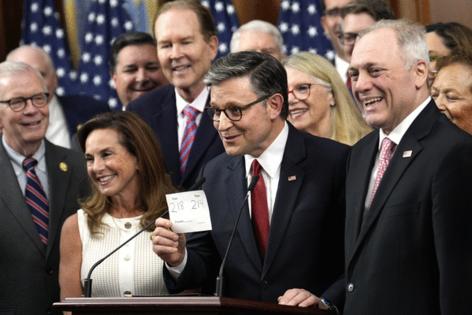Ronald Brownstein: Congress is addicted to megabills -- despite their risks
Published in Op Eds
Extraordinarily narrow and unstable House and Senate majorities have become routine in modern American politics. The frantic, final maneuvering last week before Congress approved President Donald Trump’s One Big Beautiful Bill Act shows why that’s likely to persist for some time. And that means business, local governments, non-profits and ordinary Americans need to buckle up for more hairpin turns in national policy that make it almost impossible to plan for the long term.
Political parity has become a defining feature of our times. Neither party has won a House majority greater than ten seats in each of the past three congressional sessions. That hasn’t happened since the formation of the modern party system in 1828. Likewise, one or the other party has reached 55 or more Senate seats in only three of the 13 congressional sessions since 2000, compared to 17 of the final 20 sessions of the 20th century.
With narrower margins, partisan control is flipping more frequently. Since 1980, for instance, neither party has controlled the Senate for more than eight consecutive years; never has the Senate changed hands so often over such a long period. No president has gone into a midterm election with unified control of the White House and Congress and successfully defended it since Jimmy Carter in 1978.
As last week’s debate on the sprawling GOP budget bill demonstrated, the two parties have refused to downsize their legislative ambitions to these systematically smaller and more ephemeral majorities. “Both political parties are more ideologically homogeneous than they used to be, they have big goals, they want to do a lot of things,” said Vanderbilt University political scientist John Sides. “We are not in an era where either political party comes into power and says, ‘Let’s make a few tweaks.’”
If anything, each new president seems to have internalized the likelihood that he will lose unified control of government after two years and has front-loaded his ambitions in response. Even with very small congressional margins, both Joe Biden and Trump styled themselves as transformative presidents and set out during their first year to pass a massive omnibus statute — Biden’s Build Back Better plan and Trump’s One Big Beautiful Bill. Both parties have forgotten, or rejected, the advice of Thomas Jefferson, who wrote in 1808 “that great innovations should not be forced on a slender majority.”
Republicans attuned to Jefferson’s admonition might have drafted a more fiscally and politically balanced bill that exposed their marginal members to less risk. Instead, they assembled a polarizing grab-bag of MAGA priorities that ensured an intense backlash — and pressured their marginal members to accept it anyway by conspicuously threatening primary challenges against those who balked.
In the immediate sense, that strategy worked: Just one Republican representative and two GOP senators in vulnerable seats voted against the bill. (One other in each chamber opposed it from the right.) But one cost of that strong-arm approach quickly became apparent when Senator Thom Tillis of North Carolina announced his retirement right after after Trump attacked him for opposing the bill, creating an open seat that will become Democrats’ best Senate opportunity in 2026.
Next year’s midterm election could bring more consequences. Polling has shown the bill facing enormous public opposition, particularly to its cornerstone feature of cutting federal health care programs for average families by more than $1 trillion to fund tax cuts for the wealthy.
The districts that will get hurt most by the bill are primarily non-urban, culturally conservative places where Democrats don’t expect to compete. But opposition to the principle of cutting health care for people who need it to fund tax cuts for people who don’t will likely prove a powerful Democratic argument. There are easily enough districts where white-collar suburban voters will be offended by the Medicaid cuts, even if they’re not directly affected by them, to cost the GOP the House majority next year.
The legislative contortions over the bill demonstrated how the parties have trapped themselves in a self-perpetuating cycle of instability. Because Republicans have such small House and Senate majorities, they could not give vulnerable members in either chamber a “hall pass” to vote against the measure. But because they could not grant such exemptions, Republicans increased the odds that some of those vulnerable members will lose next year and sink their majority, at least in the House. Passing a highly partisan and deeply unpopular bill with coercive demands for party loyalty isn’t a recipe for constructing durable congressional majorities.
The mismatch between the parties’ reach and their grasp makes it reasonable to expect that Congress will remain on a rollercoaster of narrow margins and frequent shifts in control. That’s not good news for any institution that needs stability from public policy, which is all of them. This bill erases Biden policies that prompted billions in investments from clean energy companies and medical providers. But if Democrats control the White House and Congress in 2029, it’s easy to imagine a different set of industries — oil companies, electric utilities, drug makers — facing equally disruptive swerves from Washington.
All American institutions would benefit from federal policies that attract support broad enough to outlast a single presidential term. The Republican choice to muscle through the most sweeping of innovations on the most slender of majorities shows why we’re unlikely to see many of those any time soon.
____
This column reflects the personal views of the author and does not necessarily reflect the opinion of the editorial board or Bloomberg LP and its owners.
Ronald Brownstein is a Bloomberg Opinion columnist covering politics and policy. He is also a CNN analyst and previously worked for The Atlantic, The National Journal and the Los Angeles Times. He has won multiple professional awards and is the author or editor of seven books.
©2025 Bloomberg L.P. Visit bloomberg.com/opinion. Distributed by Tribune Content Agency, LLC.

























































Comments